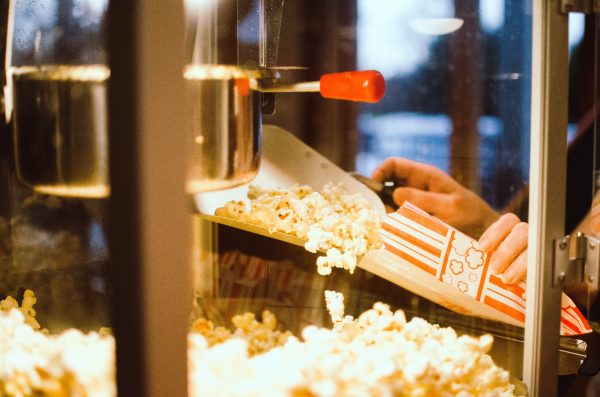
The industry has seen a lot of changes in the past few years: fluctuations in theatrical exclusivity windows, supply lines, film availability, and so much more. But for many major chains across the U.S. one point of information, at least, has been consistent: People love their movie theater concessions.
It’s been a common refrain in earnings calls from publicly traded cinema chains: Per capita revenue for food and beverage sales has been largely exceeding pre-pandemic levels. AMC, in its Q1 2023 earnings report, reported a $7.99 per patron F&B spend for its U.S. theaters—an all-time record for the country’s largest cinema chain and a substantial jump from a pre-pandemic average of $5.60. At Marcus Theatres, concessions per caps went up 5 percent between Q1 2022 and Q1 2023—in part because of inflation, says CFO and treasurer Chad Paris, but also because more customers are buying concessions—and customers who buy concessions are buying more of them.
In the five to six months after cinemas reopened, says Larry Etter, senior vice president at Malco Theatres, concessions per caps skyrocketed—lines were shorter, and “only the most honest and loyal patrons returned” to the cinema. Then, more general audiences began coming back to the movies—but inflation and a supply chain in disarray caused cinemas to raise their concessions prices, which naturally bumped up per caps again. “However, now that the grosses and attendance have increased in the past six months, per capitas have leveled out or even ebbed,” says Etter—but “per caps are still higher across the board over 2019.”
At Malco, Etter has observed this change firsthand. Shortly after their cinemas began opening in August 2022, per caps nearly doubled from what they were pre-pandemic: this despite prices that had been slashed by 30 percent and a menu that had been reduced to five key categories (one size of beverage, popcorn, candy, hot dogs, and nachos). “Historically, the per caps should have dropped by at least 25 percent. After speaking to other colleagues and peers, they reported similar data. So the question arose: Why are concessions per caps increasing?”
To find answers, Etter began gathering data and empirical observations, his conclusions coming together in a study for the Kemmons Wilson School of Hospitality and Resort Management at the University of Memphis, created in collaboration with LeRoy Conway III and Mehri Ahmadzadegan. The study, though specifically geared toward the pandemic era, provides insight into the behavior and attitudes of customers when it comes to concessions purchases in general.
Three aspects of consumer behavior—honesty, or whether a customer is sneaking in food vs. purchasing it; loyalty, or whether the customer is a regular moviegoer; and risk awareness, or the customer’s perception of how safe the cinema is—were analyzed among 569 respondents, with the goal of seeing how or if these traits (combined demographic data) had an impact on purchasing behavior.
Unsurprisingly, survey respondents overwhelmingly felt theaters were safer than other public spaces, such as restaurants, stores, or churches. They tended to go to the cinema more than the average American—based on pre-pandemic numbers—and for the most part believed it was unethical to smuggle food into theaters. Of the respondents, 99.1 percent said they buy concessions on every visit.
“Results showed that loyal, honest patrons will support the exhibition industry if movies are shown, says Etter. Customers want comfortable seats and a high quality of video and sound quality when they go to the movies, but “on the food and beverage side, keep it simple.” The success of Malco’s five-item menu prompted them to reassess their pre-pandemic offerings; when it was time to go back to a full menu, they pared things down to 12 core items. In the world of concessions, hand-held food is key, notes Etter: that can be burgers and chicken tenders, or it can be—in a theater that caters to a more upscale demographic—a cheese assortment.
Further, the majority of the study’s respondents were female, albeit not overwhelmingly—approximately 58 percent female vs. 42 percent male—among respondents who listed their gender. “Women prefer [having] choices,” says Etter of the survey, but “that doesn’t mean they’re going to buy” outside a core of menu items. Thus, he advises, slim your menu down, but not by too much. “A couple of other things stuck out for sure,” he adds. “Convenience and lines: We’ve always known that to be true. Research pre-Covid [said] that if a line has more than six people in it, specifically in a movie theater, [customers] will forego the line and go straight to their seats.” Advancements in the cinema industry—among them the widespread adoption of reserved seating and mobile ordering,” has cut down on wait time. “In all fairness, we’re in the snack business. It’s spontaneous.”
Convenience, speed, and the right balance of products on the menu: all of these contribute to higher concessions sales, even when other factors—like a pandemic, a light movie slate, or inflation—might otherwise keep people from splurging. Now, after the pandemic, “people expect to pay high prices in the entertainment and leisure channel. They are not so price sensitive as in the past,” Etter explains. While they’re willing to spend more money to treat themselves, they may do so less often than before—driving per caps higher as general sales, potentially, decline. Though rising per caps can help operators understand the growth patterns of their business, they do not negate the need for research and strategic thinking when assembling concessions menus.


Share this post